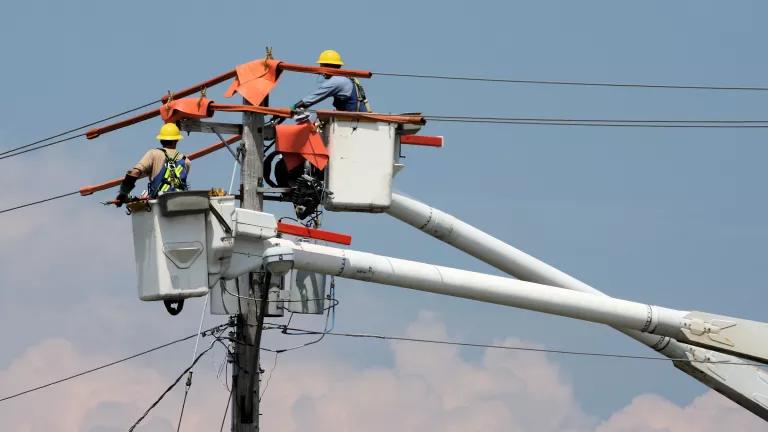
I couldn't be more proud of my boyhood state, Kansas, where three weeks ago, State senators voted to defend the state's renewable portfolio standard (RPS), sending a clear message to opponents of clean energy that the clean economy is real and is driving locally homegrown economic growth and jobs.
My colleague Kimi Narita summed up the outcome in Kansas:
The RPS signals to the wind industry that Kansas is open for business. And the wind industry has responded enthusiastically. The number of wind farms that came online from 2011 to 2012, after the passage of the RPS, nearly doubled Kansas’s installed wind capacity. The 19 wind farms operating in the state have created more than 12,300 jobs for Kansas citizens, $13.7 million in payments to landowners annually, and $10.4 million in contributions to communities each year. The RPS is good for jobs, good for the economy, and good for Kansans. It’s all just common sense.
Screenshot of NRDC's Renewables for America map showing Kansas' wind potential with existing and planned wind projects
But the battle defending state RPS's is far from over (even in Kansas, where the House is taking up the RPS right now). The American Legislative Exchange Council (ALEC)---a coalition of conservative state legislators and corporations that has teamed up with a number of deeply pocketed fossil fuel-funded groups including the Heartland Institute, the American Tradition Institute, Americans for Prosperity, and Grover Norquist's Americans for Tax Reform are on the attack to repeal or significantly weaken state RPS policies. In addition to Kansas, they have prioritized Ohio, Missouri, Michigan and North Carolina to roll back state RPS's.
The ALEC coalition hopes to of put the future of Ohio's Alternative Energy Portfolio Standard (AEPS) in doubt. This Tuesday, March 19th, the Ohio Senate Public Utilities Committee will hold its second hearing on the status of the Ohio AEPS. ALEC-member groups, Heartland Institute and the Competitive Enterprise Institute have been invited to testify alongside two renewable energy groups the Solar Electric Industry Association and the Mid-Atlantic Renewable Energy Coalition.
The Ohio AEPS in a Nutshell
Ohio enacted its Alternative Energy Portfolio Standard (AEPS) in May 2008. The law requires one-quarter (25%) of all electricity sales by Ohio utilities to come from “alternative energy” sources by the year 2025, with 12.5 percent required to come from sources identified as “renewable” and an additional 0.5 percent from solar. A nice visual summary of the law can be viewed here. The Public Utilities Commission of Ohio (PUCO) has registered over 5,300 facilities that are earning credits under the AEPS.
False and Inaccurate Claims
The ALEC-funded Beacon Hill & Heartland Institute’s (“Heartland/BHI”) report on the impacts of the Ohio AEPS is severely flawed and leads to inaccurate results. Their report concludes, “Ohio’s AEPS would lead to electricity prices increasing by 9.3 percent and the loss of more than 9,000 jobs.”
NRDC has done a legal and economic impact analysis of the AEPS law and the claims made by Heartland/BHI. To set the record straight, NRDC has found that the Heartland/BHI inputs, analysis and findings:
1. Over-inflate the input costs of renewable energy and under-inflate the input costs from competing fossil fuels. Specifically,
- Beacon Hill & Heartland assume that the cost of wind and solar energy will increase over time despite widespread analysis conclusively showing that the cost of wind and solar energy will continue to decrease by respected institutions, including the U.S. Department of Energy’s Energy Information Administration, the National Renewable Energy Laboratory, Bloomberg, and Black & Veatch. The bottom line is that the U.S. has seen a 40 percent reduction in the cost of wind energy in the last four years and an 80 percent drop in the price of solar modules in the last decade – with more significant price declines predicted in the coming decade.
- Overstate the costs of projected increase in land costs and decrease in availability of wind resources
- Under-inflate industry-standard capacity factors
- Exaggerate costs of addressing renewable energy’s variability
- Overstates costs of potential new transmission for wind power
- Ignore historic, current, and projected volatility in fossil fuel prices and potential impacts from policy.
2. Disregard all cost-containment mechanisms that help control energy costs for customers.
- Beacon Hill & Heartland ignore the cap to keep electric rates from rising no more than 3 percent–The report declares without support that the cost cap is “ineffective and meaningless,” so it was simply left out of the analysis. But this cost cap is a critical piece of the legislation, making an increase of 9.3 percent infeasible and the rest of Beacon Hill’s analysis grossly exaggerated.
3. Disregard net economic benefits from renewable energy and energy efficiency to further ensure negative impacts.
- The report does not include economic benefits of renewable energy such as new manufacturing or construction jobs, new tax base, or new lease payments to landowners. In 2011 (before the Blue Creek Wind Farm came online), the wind industry alone is estimated to have supported more than 5,000 jobs, $2.5 million in property tax payments, and more than $300,000 in land lease payments.
- NRDC has also shown that energy efficiency will provide hundreds of millions of dollars in energy bill savings to all Ohio consumers and businesses in the coming decade.
Ohio’s Legacy of Innovation
Literally and figuratively, Ohio has been at the nucleus of progressive industrial growth and development in America for its 200+ year history of statehood. Whether you point to the rise of automobile manufacturing, aviation, or companies developing among the most efficient consumer products supply chains in the world, Ohio is an innovative American industrial powerhouse.

Screenshot of NRDC's Renewables for America map showing Ohio's bioenergy potential with existing and planned renewable energy projects
Thanks to Ohio's AEPS, the state is home to a leading U.S. component supplier for wind turbine equipment manufacturers and a top producer of solar materials across the supply chain, and more than 160 companies are providing jobs in the solar industry. Fifty-five of these companies have manufacturing facilities in the state, making Ohio one of the top producers of solar materials globally. Environmental Entrepreneurs showed that in 2012 as many as 1,900 clean jobs were being created from eleven clean energy generation and manufacturing projects underway in Ohio. With continued growth in this sector, Ohio could see almost 23,000 additional clean jobs and $3.6 billion dollars of new in-state economic growth.
We cannot let greed and dirty energy reverse the growth of Ohio's clean economy -- threatening the prosperity of tens of thousands of Ohioans and their families who are employed in the state's clean energy industries. For additional information, including how you can help us defend Ohio's AEPS, check out NRDC’s new webpage that includes state-by-state fact sheets that show the benefits of state RPS's.



